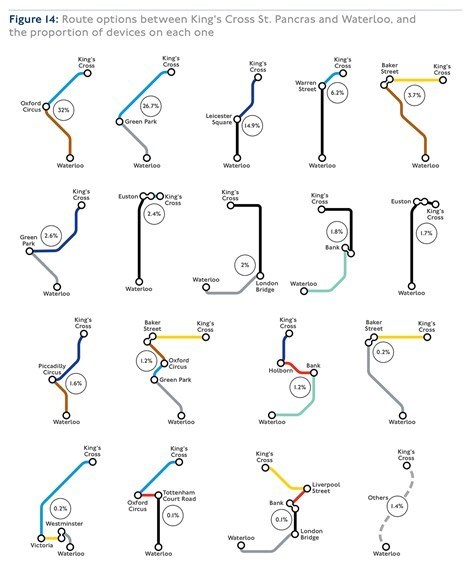
TfL will soon start using depersonalised tube wifi data to collect information about routes passengers use, and to provide better journey information.
From 8 July 2019, TfL will collect data from 260 wifi enabled tube stations. When a device has wifi enabled, it searches for a wifi network by sending out a unique identifier — known as a Media Access Control address — to nearby routers. As customers pass through stations, their route can be tracked by which routers their device connects with.
What that means, in reality, is that TfL will be able to crunch the data to see how people move around the network, both within individual stations and between stations. It gives an idea of which routes are used most, and which stations (and specific corridors or platforms) are busiest at which times.
For example, a four-week trial in 2016 found — among other things — that there are 18 different routes that passengers take to get from King's Cross to Waterloo on the tube.

This time round, TfL wants to use the information to help passengers plan their journeys, by predicting which stations will be most crowded at which times, and sharing this information on social media and the TfL website, suggesting alternative routes where necessary. The information will also be incorporated into TfL's open-data API, which can be used by app developers and researchers, and station staff will have access to the latest information, to help customers plan their journeys.
TfL already uses data from ticketing to understand the journeys people make, but this new data will give a higher level of accuracy, as it will show which routes people take within a given station, as well as which stations they travel between.

All data used will be depersonalised, meaning it cannot be tracked to a specific person or device, and no browsing or historical date will be collected. TfL has worked with the Information Commissioner's Office to address concerns around privacy and transparency.
If you do not wish for your data to be used, you can simply switch your Wi-Fi on when on the tube network to opt out. Signs informing passengers of the Wi-Fi data collection will soon appear across the network.

Lauren Sager Weinstein, Chief Data Officer at Transport for London said:
The benefits this new depersonalised dataset could unlock across our network—from providing customers with better alerts about overcrowding to helping station staff have a better understanding of the network in near-real time — are enormous. By better understanding overall patterns and flows, we can provide better information to our customers and help us plan and operate our transport network more effectively for all.
While I am excited about the potential of this new dataset, I am equally mindful of the responsibility that comes with it. We take our customers’ privacy extremely seriously and will not identify individuals from the Wi-Fi data collected. Transparency, privacy and ethics need to be at the forefront of data work in society and we recognise the trust that our customers place in us, and safeguarding our customers’ data is absolutely fundamental.
Find out more about Wi-Fi data collection on the TfL website.




